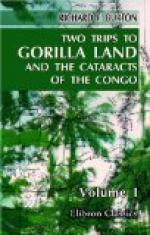The strip of gorilla-country visited by me was an elevated line of clayey and sandy soil, cut by sweet-water streams, and by mangrove-lined swamps, backed inland by thin forest. Here the comparative absence of matted undergrowth makes the landscape sub-European, at least, by the side of the foul tropical jungle; it is exceptionally rich in the wild fruits required by the huge anthropoid. The clearings also supply bananas, pine-apple leaves, and sugar-cane, and there is an abundance of honey, in which, like the Nchigo, the gorilla delights. The villages and the frequent plantations which it visits to plunder limit its reproduction near the sea, and make it exceedingly wary and keen of eye, if not of smell. Even when roosting by night, it is readily frightened by a footstep; and the crash caused by the mighty bound from branch to branch makes the traveller think that a tree has fallen.
The gorilla breeds about December, a cool and dry month: according to my bushmen, the period of gestation is between five and six months. The babe begins to walk some ten days after birth; “chops milk” for three months and, at the end of that time may reach eighteen inches in height. M. du Chaillu makes his child, “Joe Gorilla,” 2 feet 6 inches when under the third year: assuming the average height of the adult male at 5 feet to 5 feet 6 inches, this measurement suggests that, according to the law of Flourens, the life would exceed thirty years. I saw two fragmentary skins, thoroughly “pepper and salt;” and the natives assured me that the gorilla turns silver-white with age.




